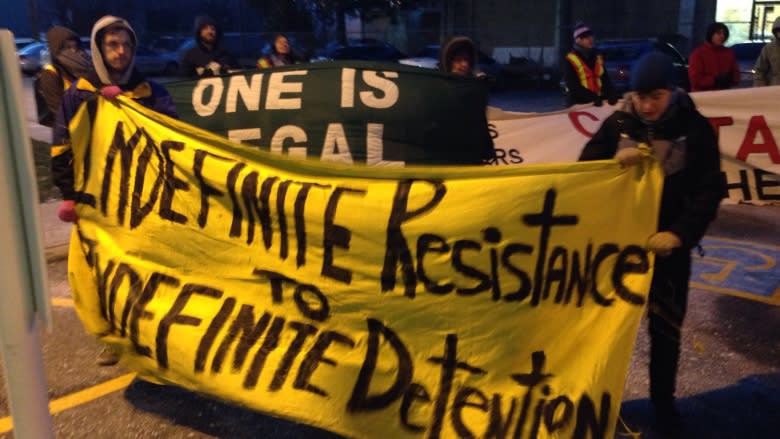Ex-detainees, supporters form human chain demanding end to indefinite immigration detention
Strangers bundled in parkas and scarves joined hands in sub-zero temperatures, forming a human chain around the Toronto Immigration Holding Centre on Saturday and demanding an end to the indefinite detention of immigrants in Canada.
More than 150 people — including former detainees and family members of some of those currently inside — gathered outside the medium-security facility in Rexdale on International Human Rights Day calling for a no more than 90-day limit to detentions as a first step to ending them completely and to show their solidarity with some 138 detainees inside its walls, according to End Immigration Detention Network numbers.
Among them was immigration lawyer Karin Baqi who noted that indefinite detention and the reality of deaths inside immigration facilities continue to be issues that many Canadians are simply not aware of.
"When it comes to immigration detention, Canada has failed to live up to even the most minimal of basic human rights and has faced enormous criticism for it," Baqi said in a statement. "We wish there was cause for celebration this Human Rights Day, but instead Canada is in gross violation."
Three detainee deaths this year alone
A total of 15 detainees have died in the custody of the Canada Border Services Agency since 2000. Earlier this year Melkioro Gahungu, 64 and Francisco Astorga, 39, died in CBSA care in the span of just one week. Police have said neither of their deaths were suspicious.
Then, in May, another death. A 24-year-old man, whose name has not yet been released, died in an Edmonton facility.
Following the March deaths, Public Safety Minister Ralph Goodale announced new initiatives to improve Canada's immigration system, including up to $138 million to transform the detention system in Canada. The Liberal government also launched consultations to inform the development of a National Immigration Detention Framework.
But critics argue the measures don't address the fact that detainees have no access to a judicial review process and worry the money will only go toward expanding the immigration prisons, rather than creating laws to end their use.
'Well, what do you do?' Goodale asks
Under the current system a migrant can be detained if the CBSA believes them to be inadmissible under the Immigration and Refugee Protection Act, poses a danger to the public, is unlikely to appear for a hearing or removal date or cannot prove his or her identity to the officer's satisfaction.
That last criterion in particular, critics argue, can leave the majority of non-criminal detainees in detention for an unlimited period of time, a practice that Canada has come under fire for by the United Nations human rights committee. Because many don't have the necessary travel documents or identification to be deported, they can languish indefinitely.
According to the Canada Border Services Agency (CBSA), there are, on average, 450 to 500 people who are detained at any given time under the Immigration and Refugee Protection Act across Canada. A 2015 report by the University of Toronto's International Human Rights Program found that Canada detained more than 7,300 migrants at a cost of more than $50 million in 2013. About one third were incarcerated in jails, even though few might be considered criminals.
"Some people would say, 'Well, Don't detain at all.' Well, what to do you do? What do you in a case of someone who is someone who is simply going to disappear?" Goodale said in an interview with CBC Radio's As It Happens earlier this year,
Solidarity especially important during holidays, say activists
"You cannot say to Canadians that people who cannot be identified are simply going to be released without any measures in place for the security of the public."
As activists continue to press the government to end the practise Sharmeen Khan, spokesperson with the End Immigration Detainees Network told CBC News she hopes the detainees in the Toronto detention facility who may be feeling especially isolated away from the families during the holiday could see and hear those who came to form an embrace around them.
"The chain was to try to show people inside that they have the support and solidarity from those outside."



